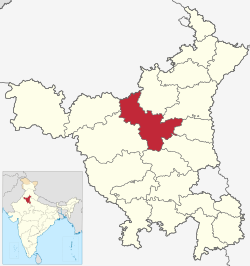Jind District
| Jind district | |
|---|---|
| District of Haryana | |
 Location of Jind district in Haryana |
|
| Country | India |
| State | Haryana |
| Administrative division | Hisar |
| Headquarters | Jind |
| Tehsils | 1. Jind 2. Julana 3. Narwana 4. Safidon |
| Government | |
| • Lok Sabha constituencies | 1. Sonipat (shared with Sonipat district), 2, Hisar (shared with Hisar district), 3. Sirsa (shared with Sirsa district) |
| • Assembly seats | 5 |
| Area | |
| • Total | 2,702 km2 (1,043 sq mi) |
| Population (2001) | |
| • Total | 1,189,872 |
| • Density | 440/km2 (1,100/sq mi) |
| Demographics | |
| • Literacy | 72.7% |
| Average annual precipitation | 434 mm |
| Website | Official website |
Jind district is one of the 21 districts of Haryana state in northern India. Jind town is the administrative headquarters of the district. It is part of Hisar Division and was created in 1966.
One of the first Sikh Kingdoms, Jind lies in the heart of Haryana and is the fourth district of the Jat belt along with Sonipat, Rohtak and Hissar.
The district derives its name from its headquarters town Jind that is said to be derived from Jaintapuri. It is also said that this town had been founded at the time of the Mahabharta. According to a legend, the Pandavas built a temple in honour of Jainti Devi (the goddess of victory), offered prayers for success, and then launched the battle with the Kauravas. The town grew up around the temple and was named Jaintapuri (Abode of Jainti Devi) which later on came to be known as Jind.
Raja Gajpat Singh, a great grandson of Phul, the founder of the Phulkian Misl, established an independent kingdom by seizing a large tract of the country, which included the territory occupied by the present district of Jind, from the Afghan governor Zain Khan in 1763 and created Jind city, the capital of the state in 1776. He built a fort here in 1775. Later, Sangrur was chosen as the capital of Jind State by Raja Sangat Singh (reigned 1822 to 1834).
The Raja of Jind is of the same family as the Maharaja of Patiala, being like him, descended from Choudhari Phul.
The Originator of the Phulkian Dynasty, Phul left six sons, of whom Tiloka was the eldest, and from him are descended the families of Jind and Nabha.
From Rama, the second son, sprang the greatest of the Phulkian houses, that of Patiala besides Bhadaur, Kot Duna and Malaudh.
In 1627 Phul founded and gave his name to a village which was an important town in the State of Nabha. His two elder sons founded Bhai Rupa whileRama also built Rampura Phul.
Jat history reveals that Jind was founded by descendants of Phool Jat. Jind was a native state in Haryana. Jind was a state of Siddhu Jats founded by grandson of Chaudhary Phul Singh who had six sons namely, 1.Tiloka 2.Ram Singh 3. Rudh 4. Chunu 5. Jhandu and 6. Takhtmal. Area of the state was 1259 sq mile and annual income of Jind state was Rs 30,00,000/-.
...
Wikipedia
